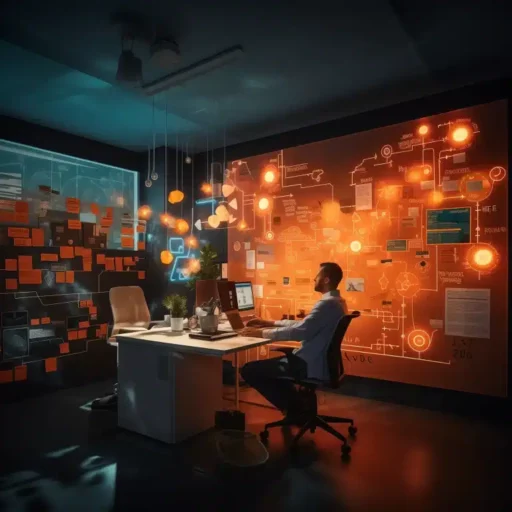
The Future of IoT Development: Key Trends and Innovations to Watch in 2023

The Internet of Things (IoT) is quickly gaining steam and becoming an integral part of modern life, especially in manufacturing, logistics, and other industrial sectors. However, the latest innovations will likely make IoT development even more essential.
Here is a closer look at the key IoT trends and innovations to watch for in 2023.
Introduction to IoT Development
In 1999, computer scientist Kevin Ashton coined the term ‘Internet of Things.’ While at Procter & Gamble, he proposed using RFID chips on products for tracking in the supply chain. Ashton cleverly incorporated the buzzword ‘internet’ into his pitch, and the phrase stuck.
IoT development is the process of connecting computers, electronics, sensors, and physical machinery to provide a centralised view of how things operate. It involves combining software and hardware to collect data and control devices.
For example, IoT solutions allow you to remotely monitor physical equipment, such as machinery on the factory floor or equipment in a hospital setting. There are also many consumer IoT products, including smart light switches, smart locks, and doorbell cameras.
IoT Development Trends
IoT development has been attracting the attention of investors and the public for over 15 years. While many exciting IoT innovations have occurred along the way, with the rapid pace of technology growth, the best developments are yet to come.
Explore some of the key IoT trends that are likely to occur throughout 2023 and beyond:
Adoption of Edge Computing
IoT developers may see an increase in requests for edge computing in 2023. Edge computing is a computing model that involves processing data locally on devices instead of on a separate application. This model can reduce network latency and improve response times.
Edge computing occurs on the outside edge of the network, which reduces demand on servers and the software that processes data. It also reduces bandwidth consumption and allows organisations to use cloud resources more efficiently.
Edge computing is especially important for IoT projects that require low latency and increased reliability, such as industrial automation, healthcare systems, and autonomous vehicles.
Increased Reliance on AI and Machine Learning
Many IoT systems already use artificial intelligence (AI) and machine learning to automate various tasks. You can expect more projects to rely on these technologies in 2023.
AI and machine learning technologies allow for faster data analysis and decision-making. AI software can easily analyse the vast amounts of data collected from IoT sensors in real time.
AI and machine learning tools can also use digital twin technology to test and analyse potential solutions to real-world problems. A digital twin is a digital copy of a physical object or process, such as the traffic flow in an urban area. Using machine learning, the software can test different scenarios to arrive at the most efficient solution.
Enhanced Security Features
IoT relies on a network of connected devices. As the number of connected devices grows, the risk of cyber security issues and the number of cybercrimes is also likely to increase. This should lead to an increased focus on securing IoT devices.
One potential IoT security solution involves the use of blockchain technology. The decentralised nature of blockchain systems eliminates some of the vulnerabilities that closed systems face, such as the risk of tampering. With a blockchain system, there is no single point of vulnerability.
IoT developers are also creating managed security solutions designed specifically for IoT systems. Managed IoT security includes the monitoring of networks and devices for any suspicious activity, helping to reduce the risk of cyberattacks.
Greater Adoption of 5G Networks
Many IoT devices connect using wireless networks. 5G technology offers the fastest speeds available for wireless networks. Adopting 5G technology can help reduce latency and improve the connectivity of IoT sensors and equipment.
Due to the potential increase in speed and performance, you can expect more regions to implement 5G networks. The switch to 5G can accommodate more devices and prevent potential bottlenecks or connectivity issues.
Adopting a faster network can also lead to greater IoT innovations. Developers can take advantage of the network to develop more responsive, reliable IoT systems.
Increased Focus on Sustainability
Sustainability may become a central theme of IoT development in 2023. At Procept, we have already seen the need for more efficient practices in everything from healthcare to agriculture.
More cities are also exploring sustainable practices that rely on IoT devices, such as smart resource management. Many urban areas are using IoT sensors to improve the efficiency of waste collection services and utilities.
Real-Life Examples of IoT Development
There are countless real-life examples of IoT technologies being used in businesses, hospitals, administrative facilities, schools, and homes. IoT technologies are also being implemented in existing devices and equipment.
For example, our engineering team added IoT features to a monitoring device for those with Parkinson’s disease. The Parkinson’s Kinetigraph now has a smart dock, allowing patients to charge their watch and submit data to their provider via the cloud.
We also partnered with a company in Melbourne to develop wearable technology. The resulting “Smash” smart device is worn around the wrist and provides valuable data to help tennis players improve their abilities.
The eHat is another great real-life example of IoT development. It is a hard hat with video/audio streaming via a connection to a smartphone. The hat offers more efficient, reliable communication in industrial settings and construction zones.
These are just a few IoT projects that we have completed over the years. While the projects were created for different industries, they all involved a tailored IoT development process.
Overall, IoT is likely to become an increasingly important aspect of how businesses and other entities get things done. With the right team, IoT technology can be developed to address almost any issue to help smart cities and organisations move towards a more connected future.
IoT Development with Procept
Our IoT engineering team has been at the forefront of IoT innovations for many years and continues to adopt and create the latest trends in this field, completing multiple business and market defining IoT projects each year for our clients.
From remote monitors for commercial fridges and freezers to smart thermometers for children and infants, Our team have worked on a diverse range of projects.
Some of our latest clients included government and Fortune 500 companies looking to increase efficiency. These groups rely on the newest technologies to improve their operations, save time, and create safer environments.
Contact our IoT team today to explore IoT solutions for your organisation.

Hi, we’re the award-winning engineering team at Procept.
We live and breath product development. Since 2006, our vision has been to make a positive difference through the application of the latest technologies to solve real-world problems and improve people’s lives.
Learn more about our product development services, engineering services, or joining our engineering team. To work with us on your next product development project, contact our team.
Let’s innovate!









